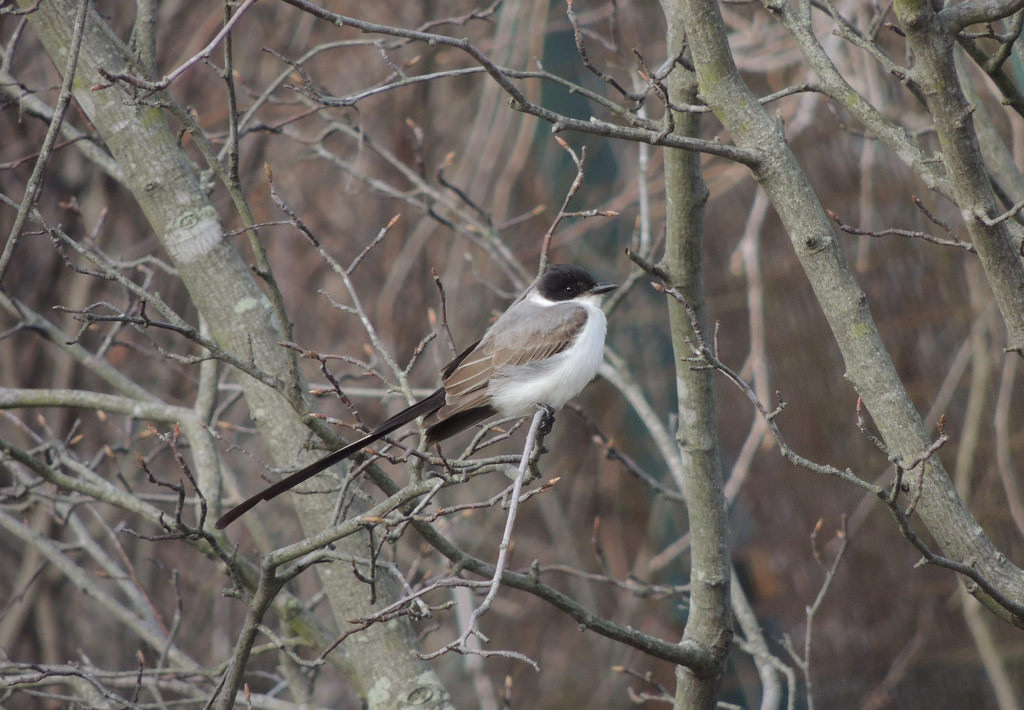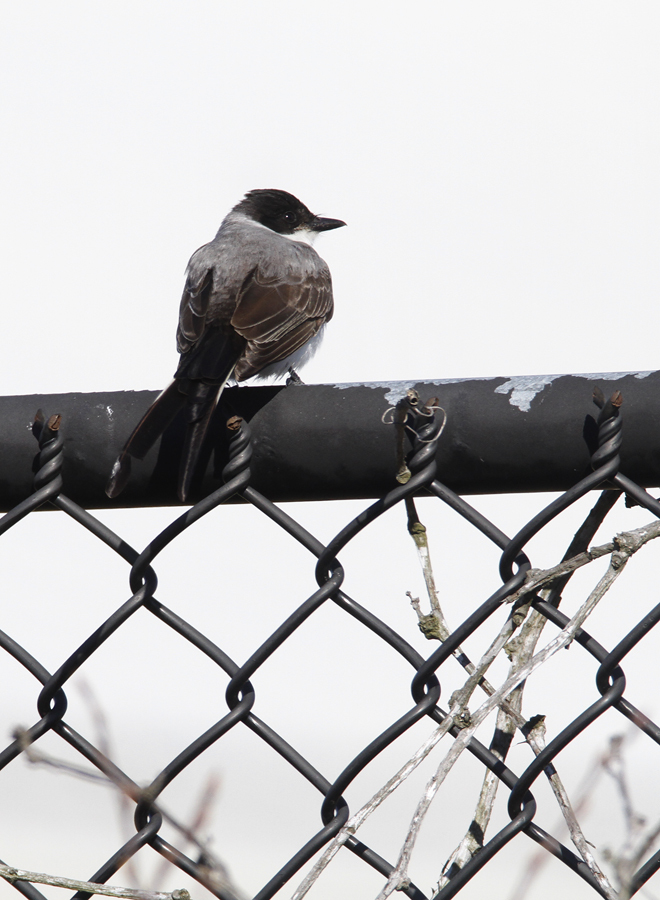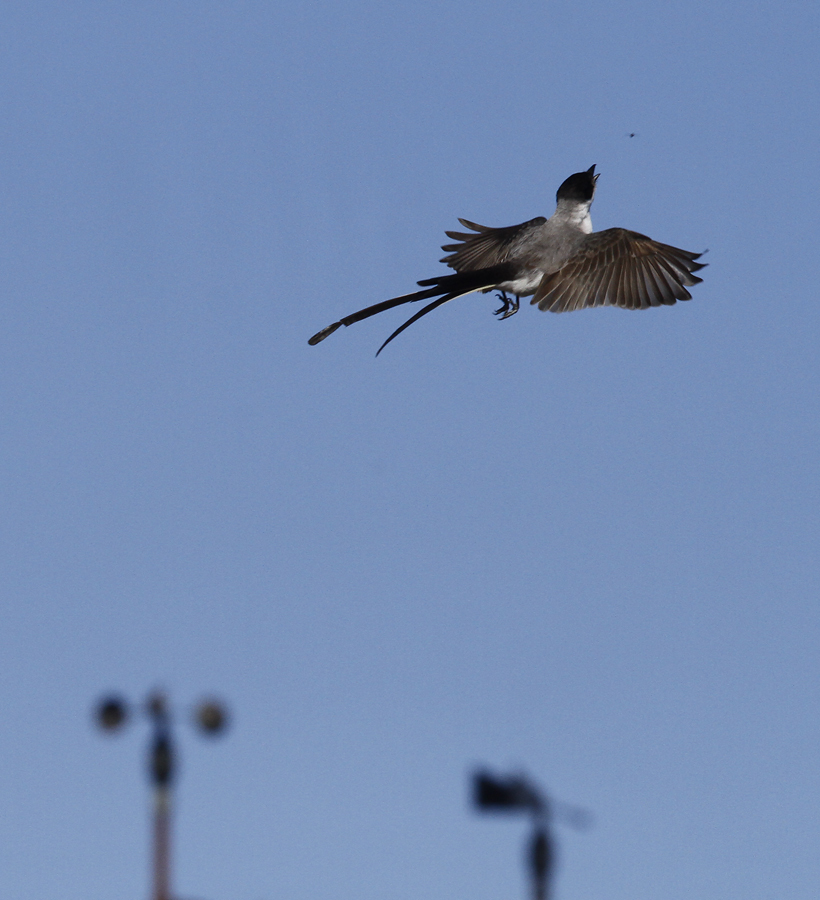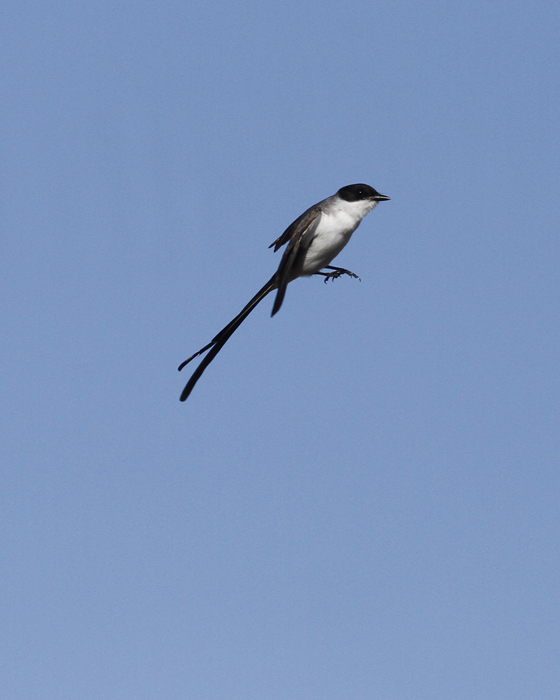Map Snapshot






30 Records
Status
Maryland has five accepted records of this rare austral migrant, the first of which was found by Hal Wierenga at Sandy Point SP (9/23/1978, MD/DCRC #1983-005). One bird spent two days in St. Mary's Co. on 9/22 and 9/23/1997 (#1997-751) and another was photographed on the telephone wires at Eastern Neck NWR, Kent Co., on 10/21/2007 (#2007-115). Scott Housten found one at Sunset Park in Ocean City on 11/23/2017 that was cooperative for a couple days (#2017-081). A major surprise showed up on 10/16/2021 in Pasadena, Maryland (#2021-117), followed quickly by a visitor to BARC, Prince George's Co. on 5/30/2022.
Seasonality Snapshot
Source: Wikipedia
| Fork-tailed flycatcher | |
|---|---|

| |
| Male T. s. monachus in Belize | |

| |
| Female T. s. monachus in Panama | |
| Scientific classification | |
| Domain: | Eukaryota |
| Kingdom: | Animalia |
| Phylum: | Chordata |
| Class: | Aves |
| Order: | Passeriformes |
| Family: | Tyrannidae |
| Genus: | Tyrannus |
| Species: | T. savana
|
| Binomial name | |
| Tyrannus savana Daudin, 1802
| |

| |

The fork-tailed flycatcher (Tyrannus savana) is a passerine bird of the tyrant flycatcher family and is a member of a genus typically referred to as kingbirds. Named for the distinguishably long, forked tail, particularly in males, fork-tailed flycatchers are seen in shrubland, savanna, lightly forested and grassland areas, from southern Mexico to south past Argentina.[1] They are most frequently observed sitting on conspicuous perches waiting for flying arthropods to fly past, they then sally out, eat their prey, and return to their perches. Northern populations near southern Mexico tend to be permanent residents, while fork-tailed flycatchers that live further south are migrants with a reputation for wandering to as far north as New Brunswick, Canada.
Taxonomy
[edit]The fork-tailed flycatcher was described in 1760 by Mathurin Jacques Brisson under the French name "le tyran à queue fourchue" (lit. 'the fork-tailed tyrant')[2] and then again in 1780 by Georges-Louis Buffon under the name "le savana"[3] (because it lived in savannahs),[4] but it was not until 1802 that François Marie Daudin coined the binomial name Tyrannus savana.[5] The type locality is Suriname.[6][7]
Four subspecies are recognised:[8]
- Tyrannus savana monachus Hartlaub, 1844 – southern Mexico to Colombia, the Guianas, and northern Brazil
- Tyrannus savana sanctaemartae (Zimmer, JT, 1937) – northern Colombia and northwest Venezuela
- Tyrannus savana circumdatus (Zimmer, JT, 1937) – east-central Brazil
- Tyrannus savana savana Daudin, 1802 – central, southern South America and the Falkland Islands
-
in flight
-
showing fork tail
Description
[edit]The fork-tailed flycatcher is white below, gray above, and has a black cap. Males sometimes show a yellow crown stripe. Males also have an extremely long, forked tail, of even greater length than that of the related scissor-tailed flycatcher. Females have a somewhat shorter tail, and it is significantly shorter in juveniles. Males are 37–41 cm (15–16 in) in length; females, 28–30 cm (11–12 in), including tail. They weigh only 28–32 g (0.99–1.13 oz), much less than closely related kingbirds, which are half the total length of this species. The tail in adult males is two to three times longer than the length of the bird from the bill to the base of the tail. Generally, males and females of the species look quite similar, but can be distinguished by the longer tail in males.[9]
The nominate subspecies T. s. savana has a darker grey back compared to T. s. monachus and T. s. sanctaemartae, which have notable light backs that contrast greatly with their black heads. Discrete notches on the primary feathers are also quite handy in identifying subspecies.[10]
Most fork-tailed flycatchers are migratory, but some stay year-round, especially in southern Mexico. Migratory fork-tailed flycatchers tend to have more pointed wings than nonmigratory flycatchers.[11]
Vocalizations
[edit]Fork-tailed flycatchers produce both vocal and nonvocal sounds. In general, they have a dry, buzzy call, and a weak "tic-note" while in flight.[12]
Their wings have been observed to make a distinct whistling note while flying overhead. In fact, research has been conducted involving distinct differences in the pitch of whistling noises by different subspecies of T. savana. This recent research has pointed towards a hypothesis that fork-tailed flycatchers are splitting into two distinct species, as the nonmigratory birds have a much-lower-pitched whistling note than the migrators. This becomes another observed difference amongst others (e.g. wing shape) pointing to the two-species conclusion.[13]
During mating displays, the males' wings may also make dry, crackling sounds; further research has investigated the use of these wing noises in potentially startling predators or would-be nest parasites (e.g. shiny cowbird).[9]
Distribution and habitat
[edit]Fork-tailed flycatchers are usually found below 1000 m elevation where they occur in a wide variety of habitats including pastures, riparian forests, forest edges, mangroves, and open residential areas with scattered trees. During migration, however, T. savana may be found in an even broader range of habitats.[14]
Its breeding range is from central Mexico to central Argentina. In most of this range, it is usually found year-round, but in the southern parts of its range, it retreats northward for the winter.
During migration, fork-tailed flycatchers are quite gregarious, nesting in flocks of up to 10,000 individuals.[15][16] This species is known to wander widely. It is spotted almost annually in the eastern United States seaboard and Canada, normally around fall (September–November).
During migration, fork-tailed flycatchers have been observed flying accompanied by relative species such as eastern kingbirds and aggressively chasing off predators.[17]
The nominate subspecies, T. s. savana, is found in central and southern Brazil, Bolivia, Paraguay, Uruguay, and Argentina (south to the Río Negro), and overwinters in Amazonia, a large portion of northern South America (i.e., within the Orinoco River Basin), and Trinidad and Tobago, occasionally appearing in the West Indies.[18]
Behavior
[edit]Breeding
[edit]Males perform aerial courtship displays involving swirling somersaults, twists, and flips. All partnered with their buzzing calls, they do their best to impress female counterparts.[9] Courtship displays also provide a usage for their long tail feathers (which are longer in males), as a way to impress potential mates.[19] Breeding seasons are dependent on subspecies and location; breeding season ranges from late summer to mid-winter.[16]
Fork-tailed flycatchers tend to build their cup nests in similar habitats to their hunting grounds (riparian forests, grasslands). They tend to prefer specific trees in specific geographic locations, such as Kielmeyera trees in central Brazil. The clutch is 1–3 eggs.[20]
Diet
[edit]This species is primarily an insectivore but will switch to berries and small fruits during winter if insects become scarce. Fork-tailed flycatchers sally from their perches to eat flying insects or glean them off of leaves and fruit. When insects become less available in winter months, they have been observed eating fruits.[16]
Fork-tailed flycatcher's long tail is an important asset in their hunt for arthropods. The long tail allows them to turn on a dime and sally after prey. In fact, fork-tailed flycatchers – though small and light – can reach speeds up to 65 miles per hour (105 km/h) and stop/turn impressively quickly using their flashy tails.[19]
References
[edit]- ^ a b BirdLife International (2016). "Tyrannus savana". IUCN Red List of Threatened Species. 2016: e.T22700503A93780761. doi:10.2305/IUCN.UK.2016-3.RLTS.T22700503A93780761.en. Retrieved 12 November 2021.
- ^ Brisson, Mathurin Jacques (1760). Ornithologie, ou, Méthode Contenant la Division des Oiseaux en Ordres, Sections, Genres, Especes & leurs Variétés (in French and Latin). Vol. 2. Paris: Jean-Baptiste Bauche. pp. 395–398.
- ^ Buffon, Georges-Louis Leclerc de (1780). "Le Savana". Histoire Naturelle des Oiseaux (in French). Vol. 14. Paris: L'Imprimerie Royale. pp. 557–558.
- ^ Jobling, James A. (2010). Helm Dictionary of Scientific Bird Names. Bloomsbury. ISBN 978-1-4081-3326-2.
given […] by de Buffon […] because it inhabited flooded savanna grasslands
- ^ Lacépède, Bernard Germain de; Daudin, François Marie (1799). "Tableau des sous-classes, divisions, sous-divisions, ordres et genres des oiseaux, par le Cen Lacépède; avec l'indication de toutes les espèces décrites par Buffon, et leur distribution dans chacun des genres, par F. M. Daudin". In Buffon, Georges-Louis Leclerc de (ed.). Histoire Naturelle par Buffon Dédiée au citoyen Lacépède, membre de l'Institut National (in French). Vol. 14: Quadrupedes. Paris: P. Didot l'ainé et Firmin Didot. pp. 197–346 [227]. Although the date of 1799 is printed on the title page, this volume was not published until 1802. For a discussion of the date see: Richmond, Charles W. (1899). "On the date of Lacépède's 'Tableaux'". Auk. 16 (4): 325–329. doi:10.2307/4069359. JSTOR 4069359.
- ^ Zimmer, John Todd (1937). "Studies of Peruvian birds. No. 27, Notes on the genera Muscivora, Tyrannus, Empidonomus, and Sirystes, with further notes on Knipolegus". American Museum of Natural History. American Museum Novitates: No. 962: 1–2. hdl:2246/3860.
- ^ Traylor, Melvin A. Jr, ed. (1979). Check-List of Birds of the World. Vol. 8. Cambridge, Massachusetts: Museum of Comparative Zoology. p. 226.
- ^ Gill, Frank; Donsker, David; Rasmussen, Pamela, eds. (July 2020). "Tyrant flycatchers". IOC World Bird List Version 10.2. International Ornithologists' Union. Retrieved 21 January 2021.
- ^ a b c Roche, John P (September 2005). "Handbook of the Birds of the World. Volume 9: Cotingas to Pipits and Wagtails. Edited by Josep del Hoyo, Andrew Elliott, and David Christie. Barcelona (Spain): Lynx Edicions. $195.00. 863 p; ill.; index. ISBN: 84–87334–69–5. 2004". The Quarterly Review of Biology. 80 (3): 365. doi:10.1086/497223. ISSN 0033-5770.
- ^ Lloyd-Evans, Trevor L. (November 2009). "Identification Guide to North American Birds, Part II.— Peter Pyle . 2008. Slate Creek Press, Point Reyes Station, CA". The Condor. 111 (4): 764–767. doi:10.1525/cond.2009.review07. ISSN 0010-5422. S2CID 84007606.
- ^ Carvalho Provinciato, Ivan C.; Araújo, Márcio S.; Jahn, Alex E. (August 2018). "Drivers of wing shape in a widespread Neotropical bird: a dual role of sex-specific and migration-related functions". Evolutionary Ecology. 32 (4): 379–393. Bibcode:2018EvEco..32..379C. doi:10.1007/s10682-018-9945-4. hdl:11449/171201. ISSN 0269-7653. S2CID 49864430.
- ^ Rosenberg, Gary H. (July 2010). "Field Guide to the Songbirds of South America.— Robert S. Ridgely and Guy Tudor . 2009. University of Texas Press, Austin. ISBN 9780292717480". Auk. 127 (3): 717–718. doi:10.1525/auk.2010.127.3.717. S2CID 86322564.
- ^ Gómez-Bahamón, Valentina; Tuero, Diego T; Castaño, María Isabel; Jahn, Alex E; Bates, John M; Clark, Christopher J (2020-08-10). "Sonations in Migratory and Non-migratory Fork-tailed Flycatchers (Tyrannus savana)". Integrative and Comparative Biology. 60 (5): 1147–1159. doi:10.1093/icb/icaa115. ISSN 1540-7063. PMID 32777043.
- ^ Roy, Michael S.; Torres-Mura, Juan Carlos; Hertel, Fritz (February 1999). "Molecular Phylogeny and Evolutionary History of the Tit-Tyrants (Aves: Tyrannidae)". Molecular Phylogenetics and Evolution. 11 (1): 67–76. Bibcode:1999MolPE..11...67R. doi:10.1006/mpev.1998.0563. ISSN 1055-7903. PMID 10082611.
- ^ Jahn & Tuero, A, D. (March 4, 2020). "fork-tailed flycatcher". Birds of the World.
{{cite web}}: CS1 maint: multiple names: authors list (link) - ^ a b c Jahn, Alex. E.; Tuero, D. T. (2020-03-04), Billerman, Shawn M.; Keeney, Brooke K.; Rodewald, Paul G.; Schulenberg, Thomas S. (eds.), "Fork-tailed Flycatcher (Tyrannus savana)", Birds of the World, Cornell Lab of Ornithology, doi:10.2173/bow.fotfly.01, retrieved 2020-09-26
- ^ Guic, Laura (2019-09-20). Ramos Mejía y las multitudes argentinas : una intervención política en Buenos Aires, hacia fines del SXIX. Universidad Nacional de Lanús. Maestría en Metodología de la Investigación Científica. doi:10.18294/rdi.2020.177030. S2CID 242506188.
- ^ Rosenberg, Gary H. (July 2010). "Field Guide to the Songbirds of South America.— Robert S. Ridgely and Guy Tudor . 2009. University of Texas Press, Austin. 760 pp., 121 color plates, 135 pages of range maps and country maps. ISBN 9780292717480". Auk. 127 (3): 717–718. doi:10.1525/auk.2010.127.3.717. ISSN 0004-8038. S2CID 86322564.
- ^ a b Jahn, Alex E.; Giraldo, Jose I.; MacPherson, Maggie; Tuero, Diego T.; Sarasola, José Hernán; Cereghetti, Joaquin; Masson, Diego A.; Morales, Marvin V. (2016-04-12). "Demographic variation in timing and intensity of feather molt in migratory Fork-tailed Flycatchers (Tyrannus s. savana)". Journal of Field Ornithology. 87 (2): 143–154. doi:10.1111/jofo.12147. hdl:11336/44789. ISSN 0273-8570.
- ^ Marini, M.Â.; Lobo, Y.; Lopes, L.E.; França, L.F.; Paiva, L.V.D. (2009). "Biologia reprodutiva de Tyrannus savana (Aves, Tyrannidae) em cerrado do Brasil Central" [Breeding biology of Tyrannus savana (Aves, Tyrannidae) in cerrado of Central Brazil]. Biota Neotropica (in Portuguese). 9 (1): 55–63. doi:10.1590/S1676-06032009000100007.
External links
[edit]- "Fork-tailed flycatcher media". Internet Bird Collection.
- Fork-tailed flycatcher Stamps[usurped] from Argentina, Brazil, Falkland Islands, Grenada, Trinidad and Tobago, and Uruguay at bird-stamps.org[usurped]
- Fork-tailed flycatcher photo gallery at VIREO (Drexel University)
- Fork-tailed flycatcher Photo at John Kormendy's Birds of Brazil website
- BirdLife species factsheet for Tyrannus savana
- Fork-tailed flycatcher species account at Neotropical Birds (Cornell Lab of Ornithology)
- Interactive range map of Tyrannus savana at IUCN Red List
- Audio recordings of Fork-tailed flycatcher on Xeno-canto.
- Citizen science observations for Fork-tailed flycatcher at iNaturalist


























